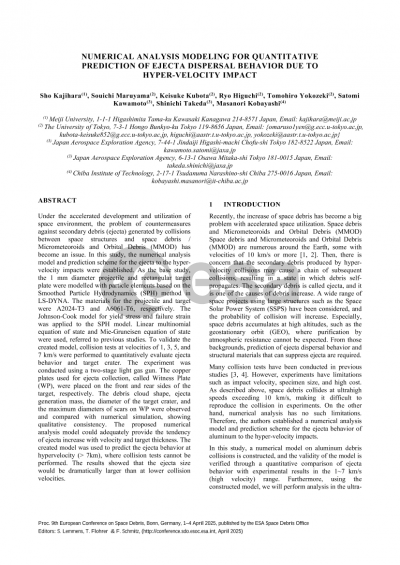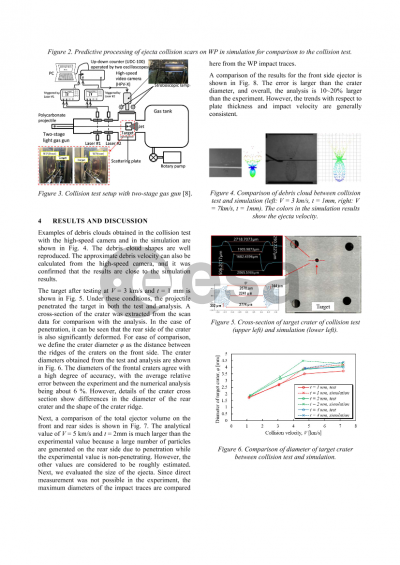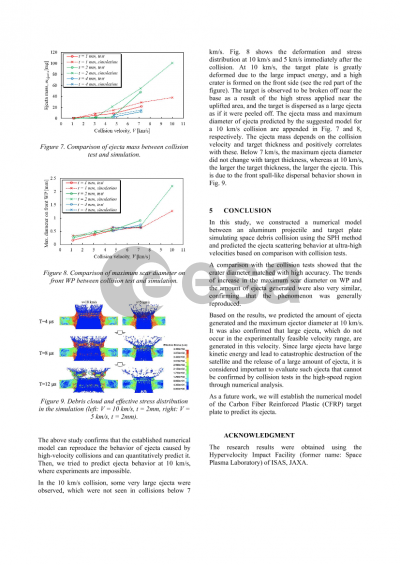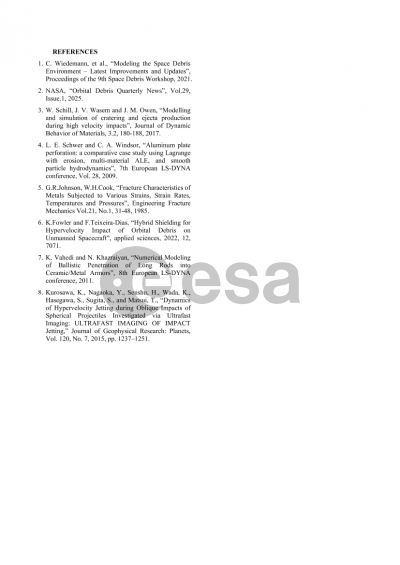Document details

Abstract
Recently, the increase of space debris has become a big problem with accelerated space utilization. Additionally, the problem of countermeasures against secondary debris (ejecta) generated by collisions between space structures and space debris / Micrometeoroids and Orbital Debris (MMOD) has become an issue. There is concern that the ejecta produced by hyper-velocity collisions may cause a chain of subsequent collisions, resulting in a state in which debris self-propagates. A wide range of space projects using large structures such as Space Solar Power System (SSPS) have been considered, and the probability of collision will increase. Especially, space debris accumulates at high altitudes, such as geostationary orbit (GEO), where purification by atmospheric resistance cannot be expected. From those backgrounds, prediction of ejecta dispersal behavior and structural materials that can suppress ejectors are required. Experiments have limitations such as impact velocity, specimen size, and high cost, but numerical analysis has no such limitations. Therefore, the authors established the numerical analysis model and prediction scheme for the ejecta of aluminum with respect to the hyper-velocity impacts. As the base study, the 1 mm diameter projectile and rectangular target plate were modeled with particle elements based on the Smoothed Particle Hydrodynamics (SPH) method in LS-DYNA. The materials for the projectile and target were A2024-T3 and A6061-T6, respectively. The Johnson-Cook model was applied to consider plastic strain, strain rate, and temperature for yield stress and failure strain. Linear multinomial equation of state was applied to the projectile and Mie-Gruneisen equation of state was applied to the target. The values of each material parameter were obtained from previous studies. After the collision of the projectile and the target, the particles scattered in various directions, but the particles that existed in clusters were considered as a single ejector. The direction and velocity of ejector dispersal that exceeded the analysis time were calculated using linear extrapolation. To validate the created model, collision tests at velocities of 1, 3, 5, and 7 km/s were performed to quantitatively evaluate ejecta behavior and target crater. The experiment was conducted using a two-stage light gas gun. The copper plates used for ejecta collection, called Witness Plate (WP) were placed on the front and rear sides of the target, respectively. Comparison of the numerical analysis with the test results showed the debris cloud shape, crater shape of the target plate, and the distribution of crater to WP were qualitatively consistent. In addition, the diameter of the target crater and the maximum diameter and number of craters on WP were observed using a digital microscope. Ejecta generation mass was calculated based on the weight change of the specimen before and after the test. The diameter of the target crater agreed with high accuracy, with the average relative error between the experiment and the numerical analysis being about 6%. The analytical values for the maximum diameter of WP craters and ejecta generation mass were 10 to 20% larger than the experimental values. However, the proposed numerical analysis model could adequately provide the tendency of ejecta increase with velocity and target thickness. The created model was used to predict the ejecta behavior at hypervelocity (> 7km), where collision tests cannot be performed. The results showed that the ejecta size would be dramatically larger than at lower collision velocities.
Preview







